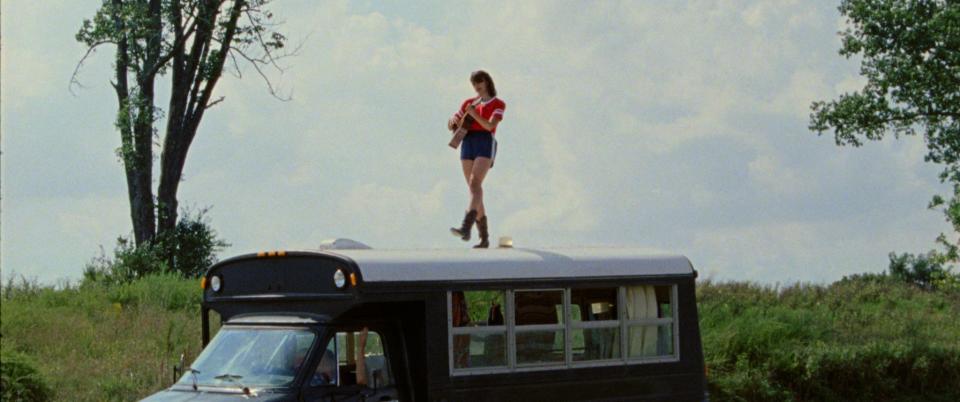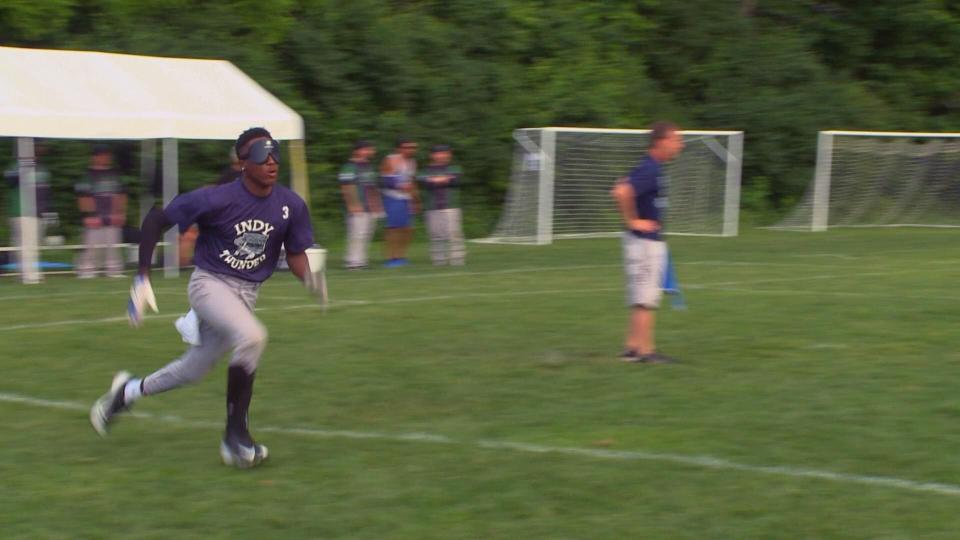Two films with Bloomington connections in Heartland Film Festival
Two films produced by current and former Bloomington residents will be featured during the 32nd Heartland International Film Festival, happening Oct. 5-15 in Indianapolis.
The festival screens independent, feature-length films from all around the world, including seven produced in Indiana and 19 U.S. and world premieres.

"Bloom" is director Mark Totte's first feature-length film. It stars actress and Bloomington native Kate Braun and was filmed over seven years in Bloomington and several other Indiana towns, according to information provided by festival organizers.
"Bloom" tells the story of a woman in her late 60s who embarks on a spontaneous road trip across the United States. Visiting places familiar and foreign, her travels evoke memories of youthful ideals and unresolved regrets as she strives to make peace with her past.
Totte produced the film using an intimate approach that involved the use of locations with personal significance for the cast and crew, populated with actors and non-actors alike in their actual homes and businesses. Places, objects, and elements from the filmmakers’ lives directed the flow of the story in a manner the director likened to a documentary film.
“We didn’t have to do much scripting — I just pointed the camera,” Totte said.
"Bloom" is not the first time Totte and Braun have collaborated. Braun played a troubled hotel custodian in Totte's 2013 short film "Slide," shot on location at the Indiana Memorial Union.
The second film with Bloomington ties is "Thunder Rolls! The World of Blind Baseball," a documentary directed by Indiana University professor of documentary filmmaking Susanne Schwibs and Chancellor's Professor Emeritus Robert Arnove.

The film follows the Indianapolis beep baseball team Indy Thunder and their coach Darnell Booker as they compete for their second world championship victory. Documenting the sport of beep baseball, a variant of baseball adapted for the blind and visually impaired, Arnove and Schwibs show how those who are often alienated because of their condition possess Olympic-level talents. By adapting the rules of traditional baseball with the appropriate equipment, beep baseball reveals the outstanding athletic talents of the players and the bonds they form with everyone along the spectrum of sightedness.
Both films will be available for streaming from Oct. 5 to Oct. 15 for $12 each.
"Bloom" will be screened at 3 p.m. Oct. 7 at the Kan-Kan Cinema & Brasserie, 1258 Windsor St., Indianapolis, and at 3 p.m. Oct. 14 at Emagine Noblesville, 13825 Norell Road, Noblesville. For tickets and a link to the virtual screening, visit https://shorturl.at/gmoxC.
Two screenings of "Thunder Rolls! The Story of Blind Baseball" are sold out. The film will play at 12:15 p.m. Oct. 7 at Landmark Glendale 12, 6102 N. Rural St., Indianapolis, and at 12:30 p.m. Oct. 14 at Emagine Noblesville. A third screening at 2:45 p.m. Oct. 14 at Emagine Noblesville has seats available. Visit https://shorturl.at/qzAP6 for a link to the virtual screening.
You can also catch "Thunder Rolls! The Story of Blind Baseball" at the Waldron Arts Center on Dec. 3.
Read on for the full interview with Susanne Schwibs about "Thunder Rolls! The World of Blind Baseball."
H-T: How did you discover the beep baseball team Indy Thunder? What inspired you to make a filmabout this team?

SS: Actually, Robert Arnove, an Avid baseball aficionado (and Cubs fan!), learned about this version of baseball that allows athletes that have low or no vision to enjoy this sport and compete at the highest levels around the world. We knew each other from our earliest collaboration on a documentary film, and also through his late wife Toby Strout (director of the Middle Way House), who was my colleague at the university many years ago. He asked if I was interested in embarking on a documentary film with him; I was intrigued, one thing led to another and here we are several years later with the result.
H-T: How did the players and the coach react when you approached them with the idea for this film?
SS: We read up on the National Beep Baseball League and discovered that Indianapolis had some top beep ball teams and placed high in the annual world series. Amazingly, the first team we called, the Indy Thunder and its coach Darnell Booker were enthusiastic about the prospect. We drove to Indy, visited the team, watched them practice, and scrimmage, and we talked. Long story short, we immediately hit it off. In fact, Darnell’s quote that opens the film “you never know who’s watching” was one of the first things he said, and we knew then that this is how we wanted to open the movie.
H-T: Did the visual impairment of the players influence any aesthetic choices of your film's production,such as sound design?
SS: We learned so much during this production. One is that any one sense or ability does not define how you can be or move in the world. For us this was a learning curve because we take sight for granted, especially as filmmakers, and maybe at the expense of our audio and sensory acuity. Filming and lighting a shot involves multiple pieces of gear, cables, cases, and people. People who do not use the sense of sight rely on memory and auditory cues, so our presence changed their environment in numerous ways, and we had to be extra conscious to keep our “production debris” organized and away from people’s travel path. We also had to communicate clearly. For example, we would tell people when we were filming, so that they were aware they were on camera rather than be “surprised” by us.
Sound Design tends to be a standard addition to films now, so I don’t think we did anything beyond what is needed to tell the story. But we did make a point to clearly feature the sounds that are necessary for orientation and for playing the game, such as the tapping of a stick, the beeps of the bases and ball, shouts of “ball,” “out,” “safe” etc.
One intriguing aspect of the game is that during any play the viewers and players must be quiet so that the athletes can hear the crucial game playing sounds. You will hear the umpires say: “quiet on the field…!” And as Darnell Booker, puts it, yes you can chant and root for your team, but during the play, “silence is gold.” One thing we have yet to do is to create an accessible, vision-described version of the film. This creates an audio track that describes the action so a viewer can follow a film without sight, similar to how closed captioning transcribes dialogue and other sounds.
H-T: Have you observed any intriguing traits among the blind athletes in your film not commonlyfound in sighted players?
SS: Beyond what I already mentioned: Beep Baseball is one of the few “blind” sports that allows the athletes to run completely free: no guidewires, no person directing the path, or other external assistance. It's the athletes batting, and then running in complete darkness to the base … and as fast as they possibly can. This is tough for sighted players, who depend so heavily on their sense of sight for orientation, as opposed to sound cues or sense of direction. We filmed a scrimmage with the Indianapolis AAA team, and everyone had a grand time navigating their way blindfolded. Not surprisingly, the Indy Thunder beat them!
H-T: You two have collaborated with one another on the film "Asi Fue: Election Time Nicaragua, 1984," produced in 1986. What were the circumstances that brought you together again for this film?
SS: Many years ago, Robert Arnove produced a documentary about the Elections in Nicaragua, for which I was editor and co-writer. It actually was my first professional gig for what was then the IU Audio-Visual Center. It’s nice to come together again after so many years!
If possible, I also would like to add a more general statement: The Indy Thunder is a truly special organization. As we followed them over the years, we saw how the team comes together as a family — with members from all walks of life and the world. It's also a local team, most of the players and volunteers are from Indy which adds to their bonds and gives the film a wonderful local relevance. We were fortunate to film many events that show their amazing athleticism, camaraderie, and democracy at team events and board meetings. We also learned so much about how individuals deal with the challenges of low or no vision. To quote Ron Brown: "blindness is not what defines you as a person." To become aware of that is not only liberating for a person with visual disabilities, it also opens the mind of anyone who watches. Last but not least, Darnell Booker is a true hero, he never stops raising his team, advocating for the game of Beep Baseball and garnering community support.
This article originally appeared on The Herald-Times: 'Bloom', 'Thunder Rolls!' included in Indy's Heartland Film Festival

